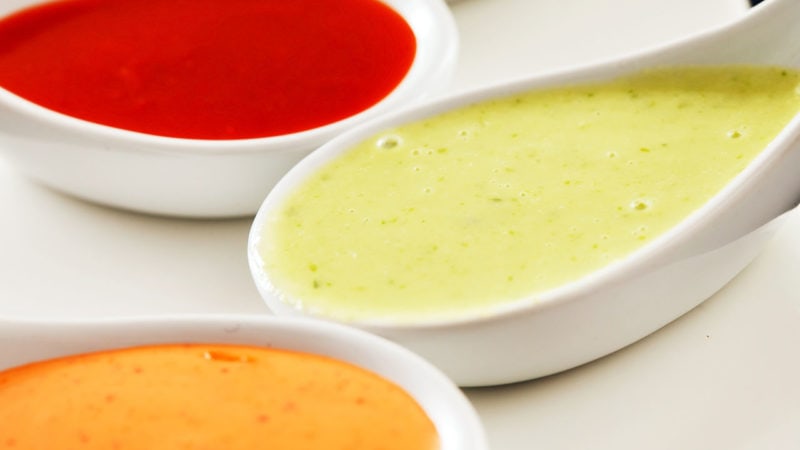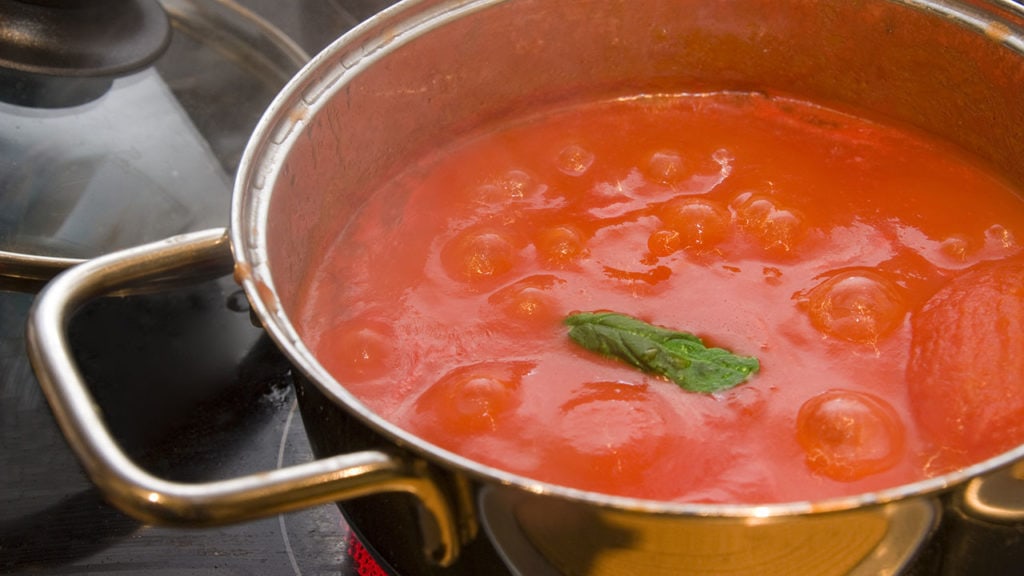Last Updated on April 1, 2022
Do you know how to cook up a quick pan sauce to elevate the perfect steak? How about a fool-proof, 3-ingredient stir fry sauce to whip up a quick dinner on hectic weeknights?
This list will introduce you to eight essential sauces that every home cook should have in their arsenal, as well as introduce the five defining sauces that serve as the basis of almost every classic sauce you can think up.
Dive in for a primer of those five quintessential sauces, as well as quick and easy homemade options like barbecue, pesto, romesco, and more.
The French Mother Sauces
First, a primer on the five mother sauces. Initially outlined by Marie-Antoine Carême in L’Art de la Cuisine Française au Dix-Neuvième Siecle and further lionized by French chef Auguste Escoffier in the early 20th century, these sauces form the foundation of French cuisine and classical cooking in general. More importantly, they are also the building blocks and inspiration for the majority of sauces you’ve likely enjoyed throughout your life.
All of these sauces are built via an emulsifier, a reduction, or a roux—a base made by combining flour and fat. See if you can spot their influence on the rest of the sauces on this list from the brief description of these five famous culinary creations.
Tomato
The simplest tomato sauce just reduces tomatoes, to which you can add flavor with ingredients like onions and garlic.
Béchamel
Rich and creamy, béchamel combines a roux and milk to form a cream sauce base. It’s often used at the base of cheese sauces, like mac n’ cheese, or Alfredo sauce.
Espagnole
Like a gravy, espagnole is a rich brown sauce, made from a roux, beef stock, seasonings, and more.
Velouté
This white sauce combines a roux with chicken stock, butter, and salt and pepper. Vegetable or fish stock and be used as well.
Hollandaise
Like the sauce found on eggs benedict, hollandaise is made from emulsified egg yolks, melted butter, and lemon juice.
8 Essential Sauces Every Home Cook Should Have in Their Arsenal
Pesto
Vibrant, green, and zesty, pesto is the ideal sauce for brightening any meal up. It’s often used in salads and pasta but is versatile enough to drizzle over pretty much any protein or savory dinner.
The green sauce derives from the cooking traditions of Genoa, Italy, and is made with garlic, pine nuts, basil, salt, parmesan, and olive oil. And while we love the traditional recipe, pesto is easily customizable. Forgoing dairy? Skip the cheese. Don’t love basil? Sub in other zingy herbs, such as parsley, or even just greens, like kale or spinach.
If you’re looking for pesto inspiration, give these recipes a try:
- Bada-Bing Meatloaf
- Boneless Country-Style Ribs with Chimichurri Pesto and Jicama Slaw
- Lemon Basil Chicken Thighs with Jeweled Quinoa and Pesto
Barbecue Sauce
We all know and love barbecue sauce, so much so that you can probably identify your preferred style. Some like it sweet, some like it vinegary, and some like it spicy.
Whichever way you like it, there’s no arguing barbecue sauce is an integral ingredient in the American kitchen. Slather it on ribs, baked or grilled chicken, or use it as a dipping sauce for kid-friendly chicken tenders.
The best part of barbecue sauce is the many, many ways you can whip it up at home. Few things are off-limits? Coffee, bourbon, fruit, and molasses are just a few of the many unique ways to set barbecue sauce apart.
Try some of these homemade barbecue sauce-laced recipes today:
Red Wine Sauce
Often considered a pan sauce, red wine sauce is the perfect finishing touch to steaks, roasts, and more. Robust red wine reduces into a rich, savory sauce, especially when accompanied with umami and savory ingredients like mushrooms, onions, shallots, garlic, and more.
To make a red wine sauce, you’ll often use pan drippings from your just-cooked hunk of meat as a base. You can, of course, also make it on its own, too.
Something to keep in mind with red wine sauce: Because the red wine reduces quite a bit and really imparts bold flavors, you’ll want to use a wine that’s good enough to drink.
Here are a couple of recipes that master red wine sauce:
- Bacon-Wrapped Filet with Buttermilk Smashed Potatoes and Mushroom Red Wine Sauce
- Flat Iron Steak with Red Wine Sauce
Stir-Fry Sauce
Every home cook should have a quick, foolproof stir-fry sauce recipe for hectic nights, because stir-fries are so versatile. They’re the kind of meal where you dump out the contents of your fridge, whip up a quick sauce, and get dinner on the table in 20 minutes flat.
Stir-fry sauces typically start with ingredients like soy sauce (substitute tamari for gluten-free, or coconut aminos for Paleo), fish sauce, sesame oil, garlic, ginger, chili garlic sauce, and more.
If you’ve got just a few Asian condiments on hand, you can probably whip up a quick stir fry sauce. In fact, even non-Asian ingredients can do in a pinch. This easy stir fry recipe combines Tamari, maple syrup, and bottled barbecue sauce to great effect.
Romesco
Ever had romesco? This almond-specked sauce hails from Spain, and adds so much refreshing, bright flavor to any dish it touches.
Originally made to be eaten with fish, romesco combines roasted tomatoes, garlic, toasted almonds, pine nuts, olive oil, and fresh peppers. It’s a little spicy, a little tangy, and oh so delicious.
Romesco sauce comes together in minutes, meaning it’s the perfect quick way to jazz up any meal. Try it dolloped atop grilled pork, like in this recipe.
Curry
Curry is as complex as it is flavorful. While it hails from the Indian subcontinent and populates many an Indian restaurant menu, it’s also found in many other cultures’ cuisines, such as Thai, Chinese, and African food.
Curries combine a significant selection of spices and flavorings with broths, purees, and creamy elements like coconut milk and coconut cream. Despite their complex flavor, there are plenty of quick curry recipes that make the sauce totally accessible to prepare at home.
Once you’ve mastered curry dishes (think chicken curry, made with chicken, veggies, curry paste, and coconut milk), try adapting that flavor in new ways, like in this coconut curry ribs recipe.
Brown Butter
Brown butter sauce is as easy as it gets, but it can truly transform the flavor of your meal. It’s simply butter browned in a pan (not burnt!), sometimes with quick additions like herbs, garlic, and even hard cheeses like parmesan and pecorino.
Brown butter elevates the richness of chicken dishes, beef and steak, and even pork. It takes minutes to prepare and can also be drizzled atop accompanying veggies and side dishes.
Here are a few ways to enjoy brown butter:
- Garlic and Lemon Marinated Chicken Breast with Brown Sage Butter
- One-Pan Filet Mignon with Rosemary Brown Butter and Sautéed Veggies
- Brown Butter Hanger Steak





